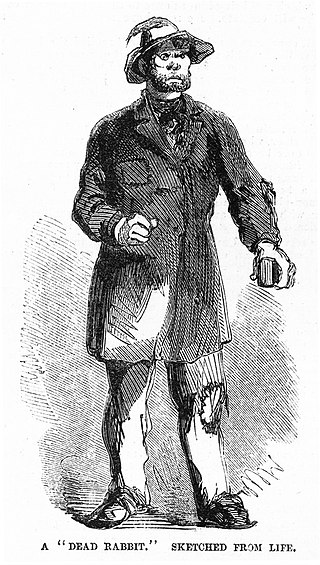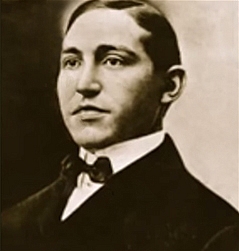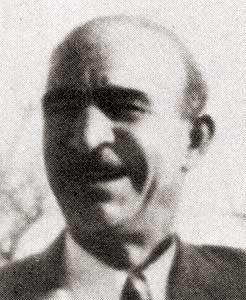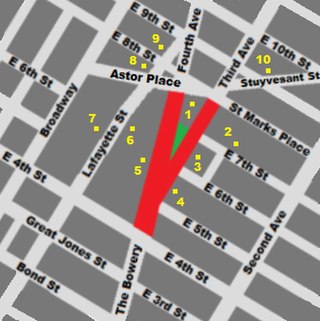
Manhattan is the most densely populated and geographically smallest of the five boroughs of New York City. The borough is coextensive with New York County of the U.S. state of New York, the smallest county by land area in the contiguous United States. Located almost entirely on Manhattan Island near the southern tip of the State of New York, Manhattan constitutes the geographical and demographic center of the Northeast megalopolis and the urban core of the New York metropolitan area, the largest metropolitan area in the world by urban landmass. Manhattan serves as New York City's economic and administrative center and has been described as the cultural, financial, media, and entertainment capital of the world.

Manhattan's Chinatown is a neighborhood in Lower Manhattan, New York City, bordering the Lower East Side to its east, Little Italy to its north, Civic Center to its south, and Tribeca to its west. With an estimated population of 90,000 to 100,000 people, Chinatown is home to the highest concentration of Chinese people in the Western Hemisphere. Manhattan's Chinatown is also one of the oldest Chinese ethnic enclaves. The Manhattan Chinatown is one of nine Chinatown neighborhoods in New York City, as well as one of twelve in the New York metropolitan area, which contains the largest ethnic Chinese population outside of Asia, comprising an estimated 893,697 uniracial individuals as of 2017.

The East Village is a neighborhood on the East Side of Lower Manhattan in New York City, United States. It is roughly defined as the area east of the Bowery and Third Avenue, between 14th Street on the north and Houston Street on the south. The East Village contains three subsections: Alphabet City, in reference to the single-letter-named avenues that are located to the east of First Avenue; Little Ukraine, near Second Avenue and 6th and 7th Streets; and the Bowery, located around the street of the same name.

The Lower East Side, sometimes abbreviated as LES, is a historic neighborhood in the southeastern part of Manhattan in New York City. It is located roughly between the Bowery and the East River from Canal to Houston streets. Historically, it was understood to encompass a much larger area, from Broadway to the East River and from East 14th Street to Fulton and Franklin Streets.

Giuseppe "Joe the Boss" Masseria was an early Italian-American Mafia boss in New York City. He was boss of what is now called the Genovese crime family, one of the New York City Mafia's Five Families, from 1922 to 1931. In 1930, he battled in the Castellammarese War to take over the criminal activities in New York City. The war ended with his murder on April 15, 1931, in a hit ordered by his own lieutenant, Charles "Lucky" Luciano, in an agreement with rival faction head Salvatore Maranzano.

The Dead Rabbits was the name of an Irish American criminal street gang active in Lower Manhattan in the 1830s to 1850s. The Dead Rabbits were so named after a dead rabbit was thrown into the center of the room during a gang meeting, prompting some members to treat this as an omen, withdraw, and form an independent gang. Their battle symbol was a dead rabbit on a pike. They often clashed with Nativist political groups who viewed Irish Catholics as a threatening and criminal subculture. The Dead Rabbits were given the nicknames of "Mulberry Boys" and the "Mulberry Street Boys" by the New York City Police Department because they were known to have operated along Mulberry Street in the Five Points.

The Bowery is a street and neighborhood in Lower Manhattan in New York City, United States. The street runs from Chatham Square at Park Row, Worth Street, and Mott Street in the south to Cooper Square at 4th Street in the north. The eponymous neighborhood runs roughly from the Bowery east to Allen Street and First Avenue, and from Canal Street north to Cooper Square/East Fourth Street. The neighborhood roughly overlaps with Little Australia. To the south is Chinatown, to the east are the Lower East Side and the East Village, and to the west are Little Italy and NoHo. It has historically been considered a part of the Lower East Side of Manhattan.

8th Street is a street in the New York City borough of Manhattan that runs from Sixth Avenue to Third Avenue, and also from Avenue B to Avenue D; its addresses switch from West to East as it crosses Fifth Avenue. Between Third Avenue and Avenue A, it is named St. Mark's Place, after the nearby St. Mark's Church in-the-Bowery on 10th Street at Second Avenue.

Paul Kelly was an Italian American mobster and former boxer, who founded the Five Points Gang in New York City. He had started some brothels with prize money earned in boxing. Five Points Gang was one of the first dominant street gangs in New York history. Kelly recruited young, poor men from the ethnically diverse immigrant neighborhoods of Lower Manhattan. The Five Points Gang included some who later became prominent criminals in their own right, including Johnny Torrio, Al Capone, Lucky Luciano, Meyer Lansky and Frankie Yale.

St. Mark's Church in-the-Bowery is a parish of the Episcopal Church located at 131 East 10th Street, at the intersection of Stuyvesant Street and Second Avenue in the East Village neighborhood of Manhattan in New York City. The property has been the site of continuous Christian worship since the mid-17th century, making it New York City's oldest site of continuous religious practice. The structure is the second-oldest church building in Manhattan.
Salvatore "Toto" D'Aquila was an early Italian-American Mafia boss in New York City of the D'Aquila crime family, what would later become known as the Gambino crime family.

Frank Scalice, also known as "Don Ciccio" and "Wacky", was an Italian-American mobster active in New York City, who led the future Gambino crime family from 1930 to 1931. He was consigliere from 1931 until his murder on June 17, 1957.
Vincenzo "the Tiger of Harlem" Terranova was a gangster and an early Italian-American organized crime figure in the United States. He succeeded Nicholas Morello as boss of the then Morello Gang in 1916 and was succeeded in turn by Giuseppe Masseria in 1922. He served as boss and underboss of the Morello crime family, today known as the Genovese crime family, the oldest of the Five Families in New York City.

Two Bridges is a neighborhood in the New York City borough of Manhattan, nestled at the southern end of the Lower East Side and Chinatown on the East River waterfront, near the footings of Brooklyn Bridge and of Manhattan Bridge. The neighborhood has been considered to be a part of the Lower East Side for much of its history. Two Bridges has traditionally been an immigrant neighborhood, previously populated by immigrants from Europe, and more recently from Latin America and China. The Two Bridges Historic District was listed in the National Register of Historic Places in September 2003.

Grand Street is a street in Lower Manhattan, New York City. It runs west/east parallel to and south of Delancey Street, from SoHo through Chinatown, Little Italy, the Bowery, and the Lower East Side. The street's western terminus is Varick Street, and on the east it ends at the service road for the FDR Drive.
Fourth Arts Block (FAB) is the leadership organization for the East Village, Manhattan cultural district in New York City, United States, building a permanent home for the arts and preserving the neighborhood's creative character. FAB advocates for the District, directs marketing and outreach efforts, leads projects that contribute to sustainable development, and supports the development and capacity of its members.

Veselka is a Ukrainian restaurant at 144 Second Avenue in the East Village neighborhood of Manhattan in New York City. It was established in 1954 by Wolodymyr Darmochwal and his wife, Olha Darmochwal, post–World War II Ukrainian refugees. Veselka is one of the last of many Slavic restaurants that once proliferated the neighborhood. A cookbook, published in October 2009 by St. Martin’s Press, highlights more than 120 of the restaurant’s Eastern European recipes.

Ray's Candy Store is a deli at 113 Avenue A in the East Village neighborhood of Manhattan in New York City. The store has been in business since 1974.
The Lower East Side History Project (LESHP) is a non-profit organization dedicated to researching, documenting and preserving the history of the greater Lower East Side of New York City.















